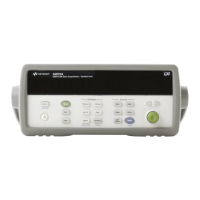5 Theory of Operation
144 Keysight 34970A/34972A Service Guide
A-to-D Converter
Unless otherwise noted, components in this discussion are located on the A4
circuit assembly (34970-66504).
The analog-to-digital converter (ADC) is used to change DC voltages into digital
information (schematic shown on page 16-20). The circuitry consists of an
integrator amplifier (U402 and U420), current steering switch U411, resistor
network U102E, voltage reference U403, ADC controller U209, and residue ADC
U205.
The ADC method used is called multislope III. It is based on patented Keysight
ADC technology. Multislope III is a charge balancing continuously integrating
analog-to-digital converter. The ADC charge balancing algorithm is always
running, even when the multimeter is not triggered. The input voltage
continuously forces charge onto the integrator capacitors C400 and C401 through
U102E–R16.
Switches U411A and U411B steer fixed positive or negative reference currents
onto the integrator capacitor to cancel, or balance, the accumulated input
charge. The level shifted (R403 and R406) output of the integrator is checked
every 2.66 µs by the A1U209 COMP input. Logic state machines in A1U209
control the U411 current steering to continuously seek an approximate 2.5 V level
on the integrator amplifier output, FLASH. If the ADC input voltage ADIN is
between ±15 V, the integrator output (FLASH) will remain within the 0 V to 5 V
range of the A1U205 on-chip ADC. An input greater than +15 V may cause the
integrator output (U402–6) to saturate at about –18 V. An input less than –15 V
may cause U402 to saturate with an output of about +18 V. The A1U205 ADC
input (FLASH) is clamped to 0 V or 5 V by R405 and CR403 to protect A1U205.
The integrator amplifier is formed by U402 and U420. Resistors R420 and R421
affect the amplifier stability. Amplifier oscillation may occur if their values are
incorrect. Amplifier U420 improves the offset voltage characteristics of integrator
amplifier U402.

